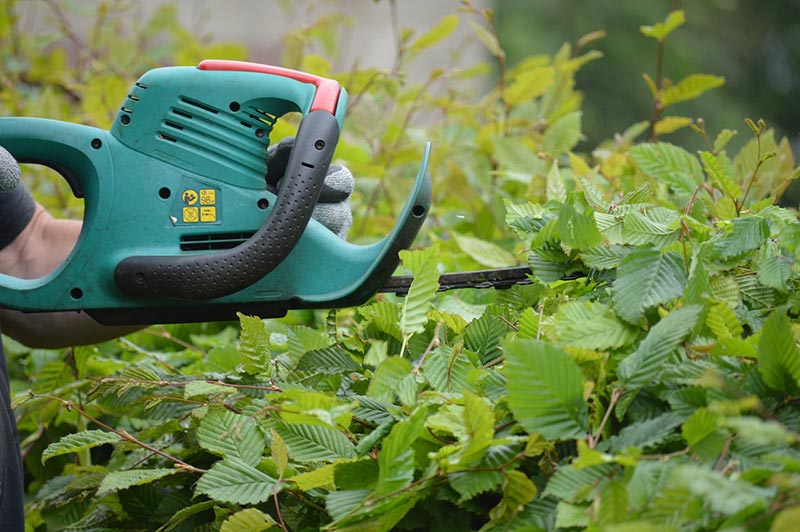Who Invented the Hedge Trimmer, and When? (History)
-
Codee Chessher
- Last updated:

You might be surprised to learn that hedges and hedge trimmers have a long, storied history. Largely used today for decorative landscaping, hedges and trimmers once had a practical purpose for agriculture. Hand shears were originally used to divide hedges from crops and fields to protect livestock, but the grandfather of the modern hedge trimmer was Leonard Wood.
In 1854, Wood imagined a device that drove beside hedges with cutters and a cutting wheel. It was a far cry from the gasoline-powered hedge trimmers we have today, but Wood was the first one to make the jump from hand shears to a machine that would save countless hours of hedge-trimming labor. Let’s check out how the hedge trimmer changed over time below in more detail.
Pre-19th Century
For as long as hedges have been maintained by humans, simple hand-operated shears have been the tool of choice. They are portable, compact, and relatively easy to make. The main issue with hand shears is that they were impractical for maintaining very large fields or crops. Before the advent of the Industrial Revolution, though, that was the peak of hedge-trimming technology.

19th Century
Many of the first tools created during the Industrial Revolution were devised to save time on labor and make work easier. Leonard Wood’s proposed invention utilized horsepower and gears to work, but it was bulky and hard to transport. As technology improved, so did hedge trimmers.
Throughout the latter half of the 19th century, several others proposed improvements to Wood’s design, with some being radical. As early as 1890, Andrew Fox conceived of a smaller trimmer with a V-shaped hood and a series of cutters. As far as history is concerned, this was very close to the modern hedge trimmer design with multiple blades. It was still too large to be practical, though.
The last major improvement to hedge trimmers in the 1800s was contributed by Robust Elliot in 1890. He leaped to propose a handheld hedge-trimming device, which was powered by a cable hooked into “any suitable power source.” This just meant any small motor but was the closest anyone had come to a completely handheld portable hedge trimmer.
20th Century
The first portable hand crank hedge trimmer was introduced by the UK company Little Wonder in 1922. As gardens became more popular in the 1900s, demand for the gadgets went through the roof. They weren’t just used by gardeners, either. Pasta makers used the trimmers to cut their handcrafted pasta to size. This trimmer used a single reciprocating blade.
The company was bought out in 1935 by Schiller, who brought the company to the US. There, Little Wonder launched the very first electric hedge trimmer in 1940, which used a single reciprocating blade. Not quite what we have today, but it’s certainly a direct relation. Today, Schiller still operates at three locations in the US.
The main difference is that their trimmer had to be connected to an electricity source. As you can imagine, this makes trimming long fields of hedges difficult, if not outright impossible. In 1945, Schiller introduced a model with two reciprocating blades. A decade later in 1955, Schiller finally introduced the first handheld gas-powered hedge trimmer, which ditched the long cable and gave gardeners more freedom.
Post-WWII, lighter and stronger alloys were more widely available, along with 2-stroke engines. The year 1962 saw Black+Decker producing their electric hedge trimmer with a built-in battery pack, which helped them become a household name. The battery was fairly primitive and not comparable to anything today, but it was revolutionary at the time.
In 1970, the chainsaw maker McCulloch began to branch out into making hedge trimmers, which were largely gas-powered. What’s notable about them is that their trimmers were focused on being lightweight and easy to start, which they continued to the modern day.
Around the same time, Echo introduced a hedge trimmer with a longer handle to increase reach. This innovation has carried on to most trimmers today and was perhaps the last major improvement to hedge trimmers.

Today
Electric and gas-powered hedge trimmers are the most popular types today, and they’re made by both old and new names alike. Black+Decker, Makita, and Bosch are some of the top names in the electric hedge trimmer market, and McCulloch still makes gas-powered trimmers under the Husqvarna brand name. Battery packs and fuel efficiency have only increased through the years, but there have been comparatively fewer major improvements made to the tool.
Conclusion
Hedge trimmers are an invaluable tool in any gardener’s shed, helping you delineate your hedges and other foliage. Although they’re still used for agriculture, most people probably think of landscapers carrying around gas or electric-powered trimmers.
Featured Image Credit: Alexas_Fotos, Pixabay
Contents
